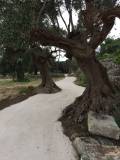The exhibition spaces located on the ground floor of the Museum were reorganised and expanded, to achieve better functional distribution. Small demolitions and the relocation of some exhibition sections have allowed for the creation of a flexible space for conferences, projections and event presentations.
The intervention sets up a new exhibition section dedicated to the sea and expands the museum size. The new route in the basement of the building is integrated with the recently opened underwater visit itinerary, dedicated to the ancient submerged port structures.
This guided underwater which, starts from the coastline, showcasing the archaeological evidence still surviving on the coast (quarry cuts, tombs and other signs of human activity), and reaches the submerged structures of the Ancient Roman seaport, along with other points of interest located underwater; this allows for direct access with a view of the submerged archaeological heritage integrated into the current landscape and the historical and cultural complex as a whole. In the new section of the museum dedicated to findings retrieved from the sea, visitors can enjoy the sensation of exploring an underwater world. The route is composed of stations, each of which is characterised by different experiences and tools available.
From the entrance, the experience of marine immersion starts: the floor is transformed, in a matter of a few steps, from a sandy surface to a liquid, resin-made mirror-like surface with a glossy finish. In the space called the “Immersion Room”, visitors will enjoy a sensory experience, with the impression of walking across the sea bed.
A different space contains displays and monitors documenting the relation between man and the marine environment. A third space hosts a 3D reconstruction of the Egnazia seaport, several wooden wreckage splints, oil lamps and naval furnishings. Other spaces feature an aquarium and a large interactive table, detailing topographical images of the archaeological site.
The final exhibition space is dedicated to the display of several marine findings, which have become protected historical artifacts.
The work on the external area consists in the redevelopment of the former caretaker’s house and its conversion into a reception and information area, providing all essential services to visitors: a new parking area for cars and buses with brand new landscaping, a food lounge a shaded outdoor area, toilets, a bookshop and a series of information devices. The project also intervenes on the area outside the museum, with construction of a new architectural paving made with environmentally sustainable materials, along with the reconfiguration of the museum’s access and exit system for the disabled.
In order to promote a more appropriate use of the archaeological area, new touristic itineraries have been set up, such as the “Egnazia Sotterranea”, an itinerary dedicated to underground structures, monuments, tombs, and a large Cryptoporticus: interventions for these itineraries include restoration of the structures and external renovation works, along with a reorganisation of the accesses and lighting systems.
In order to promote a more appropriate use of the archaeological area, new touristic itineraries have been set up, such as the “Egnazia Sotterranea”, an itinerary dedicated to underground structures, monuments, tombs, and a large Cryptoporticus: interventions for these itineraries include restoration of the structures and external renovation works, along with a reorganisation of the accesses and lighting systems.
Read Less






















